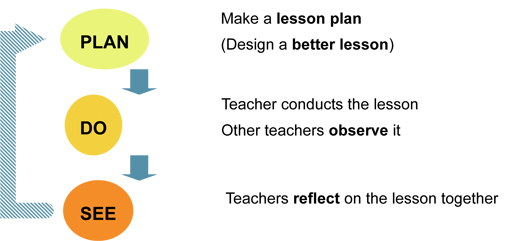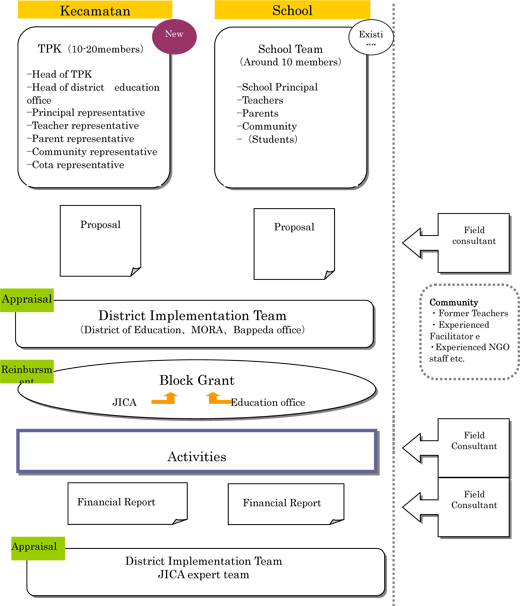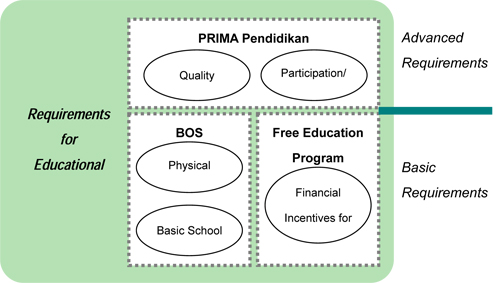What is the PRIMA-P model? (2)
Lesson Study
Lesson study was started in Japan around the 1870s. This is a method of case analysis on the practice of lessons, aiming at teachers’ professional development through mutual learning from real practices in the classroom. Lesson study consists of three parts or steps: Plan (lesson planning), Do (conducting the lesson and observation) and See (reflection) as shown in Figure 2. At the Plan step, a teacher or a group of teachers makes a lesson plan. At the Do step, one teacher (model teacher or demonstration teacher) conducts a lesson based on the plan and colleagues observe the lesson. At the See step, teachers reflect on the observed lesson together.
Figure 2 Three Steps of Lesson Study
Teachers repeat these three steps throughout the year changing the lesson topics and the model (demonstration) teacher. Commonly, one open class and reflection are held once a month.
When SISTTEMS introduced Lesson Study to Indonesia, it experimented two alternative ways of Lesson Study: MGMP-based Lesson Study and school-based Lesson Study. Table 2 summarizes and compares the two ways of Lesson Study:
Table 2 Two Ways of Lesson Study under SISTTEMS
| MGMP-Based Lesson Study | School-Based Lesson Study | |
|---|---|---|
| Participants | All teachers of the same subject matter in the wilayah | All teachers of the same school, of all subject matters |
| Activity base | Wilayah-based MGMP (all SMP and MTs) | School |
| Leader | Facilitators chosen from among the participating teachers | Principal and Facilitators chosen from among the teachers |
| Frequency | Biweekly. Plan session in the first week; Do and See sessions in the third week of the month (standard case) | Biweekly. Plan session in the first week; Do and See sessions in the third week of the month (standard case) |
Since both ways have their own advantages and worked well, PRIMA Pendidikan has also adopted the two styles of Lesson Study simultaneously.
Mechanism and Structure of PRIMA Pendidikan
Following organizations or bodies are created to implement PRIMA Pendidikan.
School Team: Each participating school is requested to organize School Team. Basically, School Team consists of all members of School Committee and Principal. This new School Team has been necessitated to ensure Principal’s involvement because the official School Committee excludes Principal from its members.
TPK (Tim Pengembangan Pendidikan Kecamatan, Kecamnatan Education Development Team): TPK is to be newly established at each target kecamatan. Its members should include representatives of kecamatan officials, principals, teachers, parents, community members and village heads.
Kabupaten Implementation Team (KIT): This Team is an official body responsible for the implementation of PRIMA Pendidikan in the target kabupaten. It usually consists of officials from Dinas Pendidikan, BAPPEDA and Kandepag (Kabupaten Office of Ministry of Religious Affairs).
PRIMA Pendidikan’s mechanism is as follows (Figure 3):
- School Teams and TPKs make proposals.
- KIT reviews the proposals.
- Once proposals are approved, Kabupaten Education Office disburses the block grant (under the program, this budget initially comes from JICA)
- School Teams and TPKs conduct the activities according to their proposals using the block grant.
- KIT monitors the activities.
- At the end of the activity period, School Teams and TPKs prepare and submit the Activity Report and Financial Report.
Lesson Study is part of their proposed activities. Under PRIMA Pendidikan, in each target kabupaten, one pilot TPK conducts MGMP-based Lesson Study and one pilot school conducts school-based Lesson Study.
Figure 3 Implementation flow of PRIMA-P action plan activities
BOS, Free Education Program and PRIMA Pendidikan
In South Sulawesi province, three education programs are currently being implemented in parallel. They are:
- BOS (Bantuan Operasional Sekolah, School Operation Fund)
- Free Education Program (Pendidikan Gratis)
- PRIMA Pendidikan
These three programs have one element in common: block grant for schools. However, the programs’ purposes and focus differ and, as a result, the block grants have different characteristics. Table 2.2 below summarizes their main differences.
The three programs and their block grants have distinct characteristics. This means that the three programs can complement one another by making the best use of their respective advantages. See Table 3 below.
Table 3 BOS, Free Education Program and PRIMA Pendidikan: Characteristics
| BOS | Free Education Program | PRIMA Pendidikan | |
|---|---|---|---|
| Strength |
|
|
|
| Weakness |
|
|
|
| Recommended main purpose |
|
|
|
It is highly reasonable and strongly recommended to differentiate the main purposes of the three programs in consideration of their respective strengths (Figure 4):
- BOS is the “staple food” for schools. It should cover the very basic infrastructure of schools and provide basic school supplies.
- Free Education Program is another “staple food.” However, this should mainly be used as financial incentives for educational personnel.
- PRIMA Pendidikan, by contrast, is a “nutritional supplement” for schools. It should finance improvement of education quality and promotion of community participation and parents’ awareness in educational development.
Figure 4 Relationship of the Three Programs
- About JICA
- News & Features
- Countries & Regions
- Our Work
- Thematic Issues
- Types of Assistance
- Partnerships with Other Development Partners
- Climate Change / Environmental and Social Considerations
- Evaluations
- Compliance and Anti-corruption
- Science and Technology Cooperation on Global Issues
- Research
- JICA Development Studies Program / JICA Chair
- Support for the Acceptance of Foreign HRs / Multicultural and Inclusive Community
- Publications
- Investor Relations
